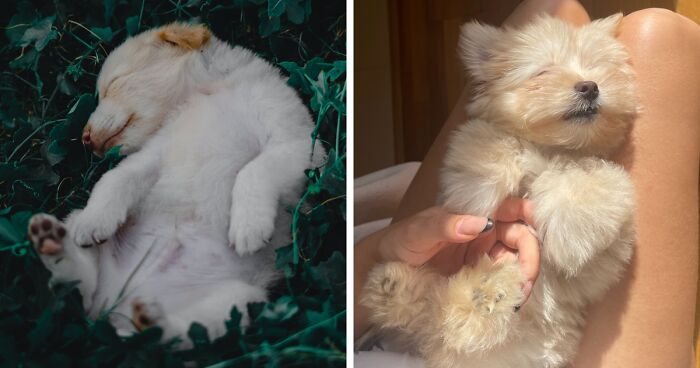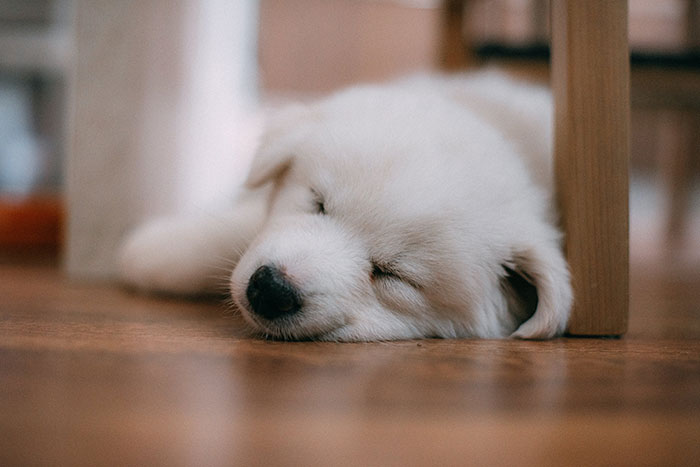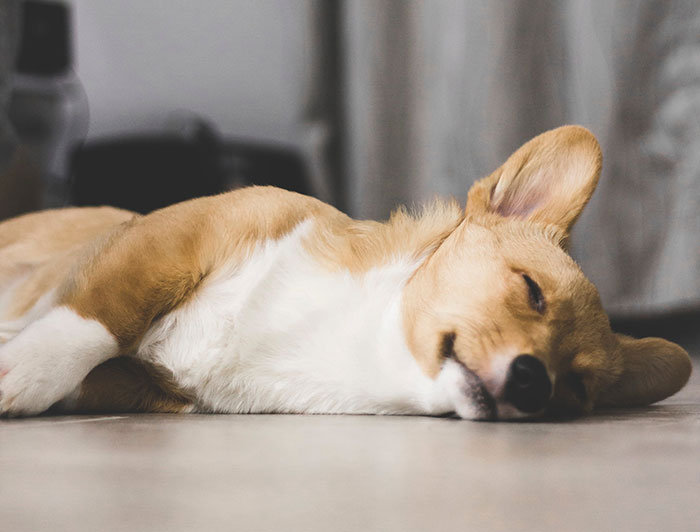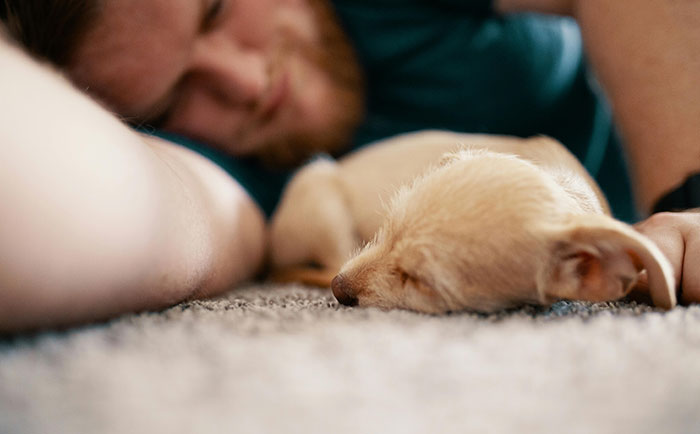There is nothing like a good nap after a good session of fetch. Having a puppy can be one of the happiest times in your life, but there may be times when it gets a bit scary when things happen that you don’t understand.
As a new dog parent, you might find yourself admiring your new, fluffy addition while they sleep. What if they’re breathing too fast? What could this mean?
- Puppy fast breathing during sleep is normal & often due to exercise.
- Dogs can show signs of stress or dream during rapid sleep breathing.
- Puppies need 18-20 hours of sleep and may breathe fast during REM.
- Contact vet if puppy has breathing issues with gums color changes.
Seeing your pup with an increased respiratory rate while sleeping can be alarming, but it typically isn’t anything to worry about. This is all just a part of getting to know your dog and the mannerisms that come along with them.
Noticing fast breathing while asleep may have you second-guessing yourself about your puppy’s normal, awake breathing rate. There are a couple of different reasons why your puppy is breathing differently and having the ability to identify them will help calm your worrying mind.
The information provided herein is for informational purposes only. Please refer to our disclaimer for more details..
Causes of Fast Breathing During Sleep
Image credit: Tanya Gorelova
Puppies have one priority in their life during adolescence: play! With normal exercise, your dog’s heart rate will naturally increase and he will start to breathe faster to keep up with his bounding heart.
To have an elevated heart rate and respiratory rate after playing or exercise is completely normal and sometimes it will linger as your puppy drifts off into a nap.
Sometimes, he won’t be able to keep his sleepy little eyes open as his body works to bring his pulse and breathing back down to a resting rate- his body is still developing and is not yet used to vigorous exercise, hence the sudden need for a good nap.
Your puppy’s breathing can change as he drifts off into a dream. Yes, dogs dream, too! Interestingly enough, experts found that a sleeping puppy’s brain can reflect a brain that’s awake. It can be tempting to wake a pup from their sleep when their breathing quickens, but it is important to allow them to hold their sleep cycle to ensure they are getting quality rest.
As long as no signs of stress are seen along with barking or shaking, an increased respiratory rate is nothing to be concerned about. For all we know, your puppy could be dreaming about playing in a never-ending field or winning a race! Sounds exhausting!
While we understand that an increased respiratory rate is a natural response to play and exercise, it is also important to know what labored breathing looks like, especially if your family chooses to love a brachycephalic (wide and short snout) puppy.
Dogs that are classified in the brachycephalic category are predisposed to breathing difficulties due to their airway composition. As you are monitoring breathing, be diligent about observing any wheezing or extensive abdominal heaving.
These can be tell-tale signs of dyspnea, or labored breathing. If you ever believe that your dog is struggling to get breaths in or out, contact your vet immediately.
Thermal regulation can come into play when breathing is involved. Dogs cool themselves down by panting as their body regulates itself back down to a normal and comfortable temperature.
On hot days, make sure that your dog has a cool indoor space where they can relax with a cold bowl of water for proper hydration.
Understanding Your Puppy’s Sleep Cycle
Image credit: Javon Swaby
Growing up is tough stuff. Experts have found that puppies spend roughly 18-20 hours a day sleeping. This is vital for both physical and behavioral development. Just like humans, pups go through the stages of sleep: light, REM, and deep.
However, unlike humans, they can run through that cycle multiple times a night, causing them to stir and change their breathing patterns.
The REM sleep cycle is when you are likely to see rapid breathing in your little one. At this time, the body is working to pull in more oxygen, therefore the respiratory rate will increase. This could also mean that they’re drifting off into dreamland or just simply still trying to settle down after a day of adventure.
As any dog owner knows, bladder control is one of the hurdles you have to jump through during puppyhood. Because of this, your puppy may stir in the middle of the night, his respiratory rate increasing as he realizes he needs to use the bathroom, as soon as possible!
Creating a comfortable and calm sleeping environment can prevent your puppy from running through multiple sleep cycles a night, therefore keeping their respiratory rate even and relaxed.
Puppies need a safe place and a spot that is solely theirs, like a comfy kennel or plush dog bed. If they’re sleeping in a place that is safe for them, they are far more likely to relax and stay that way throughout the night.
A good night’s sleep will usually follow up a day full of activity and adventure, so you must be giving your new friend the enrichment he needs throughout the day. This can include multiple walks, stimulating playtime, and plenty of interaction with family members.
After a fulfilling day, your puppy should fall into a deep sleep, keeping their breathing nice and regulated- one less thing for you to worry about as a new puppy owner.
Learn to Count their Breaths per Minute
Image credit: Josh Sorenson
If you’re still feeling anxious and uneasy about your puppy’s faster breathing, learning to count their breathing rate is a surefire way to give you some peace of mind.
When worrisome breathing appears, remain calm and focus on their chest; an inhale and exhale is counted as one breath. When you are confident with the rhythm, use a timer or your phone to start a 30-second clock.
You will count the number of breaths within that allotted amount of time and then multiply it by two. This will give you the number of breaths they are taking in a 60-second, or one-minute, span.
If you’re uncomfortable with multiplying, then just count the number of breaths for one minute straight. A young dog will likely take anywhere from 20-45 breaths per minute, whereas a large or older dog will land around 12-30 breaths per minute.
Remember, smaller dogs may have a higher breath count whereas larger dogs may be lower. It is best practice to keep a note or journal of the pet’s respiratory rate so you can find patterns and understand what their normal breathing may look like.
Disorders that Hinder Puppy Respiration
If your veterinarian determines that your puppy is breathing fast because of an underlying issue, be prepared to be well-versed in the following areas so that you can understand how to best help your pup.
Tracheal collapse
The trachea is a large tube that sits close to the esophagus and is responsible for transporting oxygen into the body. In cases where the trachea collapses on itself, the cartilage breaks down, creating an area that is too small for air to flow through.
When the dog is breathing fast, their respiratory effort can become labored. This disorder is typically only seen in older dogs, not puppies.
Diaphragmatic hernia
Typically a congenital effect in young puppies due to lack of development, the organs in the diaphragm can push up against the lungs, causing a deficit in breathing. This defect can only be corrected with surgical intervention.
Dehydration
Canine dehydration can be identified when the dog’s pant is heavy and fast with shorter breaths. Paired with a high heart rate, dull mentation, and the refusal to be active, dehydration can leave a dog feeling pretty awful at an alarming rate.
If you suspect that your dog is dehydrated, they may also have a dry nose, mouth, and dry gums. A dog suffering from advanced dehydration may need hospitalization and to receive intravenous fluids.
Laryngeal paralysis
The laryngeal folds are located in the back of the throat and can adapt to breathing, eating, and drinking. Sometimes, the folds have nerve issues which result in closing and opening at the wrong times.
The paralysis of the laryngeal folds can greatly hinder the airflow of oxygen into the lungs of the puppy. A tell-tale sign of laryngeal paralysis is a wheezing or honking noise when the dog attempts to breathe rapidly. In most cases, this disorder is caused by trauma but can develop in dogs as they age.
Heart disease
The heart’s main role in the body is to pump healthy, oxygenated blood in circulation. A disturbance in this system results in heart disease, to rope all the potential conditions under one term.
Some more specific terms can include dilated cardiomyopathy, hypertrophic cardiomyopathy, pericardial effusion, and valve disease. Without oxygen flowing appropriately due to an issue with the heart, your puppy may begin to breathe heavier or more rapidly to compensate.
Respiratory disease
Sometimes, bacteria, fungi, and viruses attack the lungs and make it difficult for the puppy to breathe as the body works hard to clear the foreign infection. If the infection clings to the lung tissue, it can make it increasingly difficult for your dog to get the correct amount of oxygen.
Vaccines are available to prevent contagious illnesses, such as kennel cough. It can inflame the trachea and produce a dry and painful cough that originates in the lungs. This problem is common when a large number of dogs are kept together, such as in a boarding facility or kennel. However, experts have learned that the most common respiratory disease is pneumonia and requires hospitalization.
Pain
Even as humans, when we feel pain our breathing rate can drastically change. Pain can come in many different forms and dogs will use their breathing pattern to regulate their nervous system. This breathing pattern may look quicker or they will take bigger breaths with more depth.
Overheating
The most extreme form of overheating can lead to heatstroke. When a dog is trying to cool itself down, their breathing will be rapid to aid in dropping their internal temperature. Dogs cannot sweat like humans do, so their cooling system is directly correlated to their breathing.
Experts tell us that it is not safe to keep pets outdoors above the temperature of 90 degrees Fahrenheit. If you live in a hot climate, it is best practice to ensure that your dog has a cool, safe place to regulate their body temperature.
Do not let becoming familiar with the systemic diseases that can affect your pet’s respiratory effort and rate intimidate you. If you still feel that you need further support and guidance, do not hesitate to set up a meeting with a veterinary professional.
When to Contact Your Vet
Your veterinarian is always going to be willing to address any concerns you have as a new puppy owner. Your pup will go through a series of vaccines that have to be bolstered early in on their lives. This is an ideal opportunity for you to regularly observe their breathing and address your concerns with your vet.
Familiarize yourself with emergent situations when it comes to your puppy’s breathing so you can assess the situation if the puppy is breathing fast or too slow. Contact your vet if you notice that their gums are bright red, white, or blue, if they have a decreased appetite, if they are exercise intolerant, or if their mouth is gaping open while breathing. A veterinarian will be able to perform further diagnostics to get to the bottom of any underlying health issue that may be a cause for concern.
295views
Share on Facebook
 Dark Mode
Dark Mode 

 No fees, cancel anytime
No fees, cancel anytime 





















































1
0